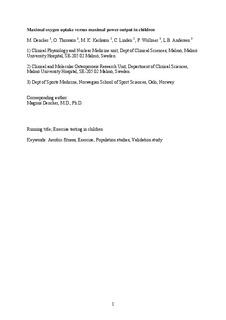| dc.contributor.author | Dencker, Magnus | |
| dc.contributor.author | Thorsson, Ola | |
| dc.contributor.author | Karlsson, Magnus K. | |
| dc.contributor.author | Lindén, Christian | |
| dc.contributor.author | Wollmer, Per | |
| dc.contributor.author | Andersen, Lars Bo | |
| dc.date.accessioned | 2009-11-02T12:33:37Z | |
| dc.date.issued | 2008-11 | |
| dc.identifier | Seksjon for idrettsmedisinske fag / Department of Sports Medicine | |
| dc.identifier.citation | Journal of Sports Sciences. 2008, 26(13), 1397-1402 | en |
| dc.identifier.issn | 0264-0414 | |
| dc.identifier.uri | http://hdl.handle.net/11250/170767 | |
| dc.description | I Brage finner du siste tekst-versjon av artikkelen, og den kan inneholde ubetydelige forskjeller fra forlagets pdf-versjon. Forlagets pdf-versjon finner du på www.informaworld.com: http://dx.doi.org/10.1080/02640410802199789 / In Brage you'll find the final text version of the article, and it may contain insignificant differences from the journal's pdf version. The original publication is available at www.informaworld.com: http://dx.doi.org/10.1080/02640410802199789 | en |
| dc.description.abstract | Maximal oxygen uptake ([Vdot]O2max) is considered the optimal method to assess aerobic fitness. The measurement of [Vdot]O2max, however, requires special equipment and training. Maximal exercise testing with determination of maximal power output offers a more simple approach. This study explores the relationship between [Vdot]O2max and maximal power output in 247 children (139 boys and 108 girls) aged 7.9-11.1 years. Maximal oxygen uptake was measured by indirect calorimetry during a maximal ergometer exercise test with an initial workload of 30 W and 15 W · min-1 increments. Maximal power output was also measured. A sample (n = 124) was used to calculate reference equations, which were then validated using another sample (n = 123). The linear reference equation for both sexes combined was: [Vdot]O2max (ml · min-1) = 96 + 10.6 · maximal power + 3.5 · body mass. Using this reference equation, estimated [Vdot]O2max per unit of body mass (ml · min-1 · kg-1) calculated from maximal power correlated closely with the direct measurement of [Vdot]O2max (r = 0.91, P <0.001). Bland-Altman analysis gave a mean limits of agreement of 0.2±2.9 (ml · min-1 · kg-1) (1 s). Our results suggest that maximal power output serves as a good surrogate measurement for [Vdot]O2max in population studies of children aged 8-11 years. | en |
| dc.format.extent | 118085 bytes | |
| dc.format.mimetype | application/pdf | |
| dc.language.iso | eng | en |
| dc.publisher | Routledge Taylor & Francis | en |
| dc.subject | aerobic fitness | en |
| dc.subject | exercise | en |
| dc.subject | population studies | en |
| dc.subject | validation study | en |
| dc.title | Maximal oxygen uptake versus maximal power output in children | en |
| dc.type | Peer reviewed | en |
| dc.type | Journal article | en |
| dc.subject.nsi | VDP::Social science: 200::Social science in sports: 330::Other subjects within physical education: 339 | en |
| dc.source.pagenumber | 1397-1402 | en |
| dc.source.volume | 26 | en |
| dc.source.journal | Journal of Sports Sciences | en |
| dc.source.issue | 13 | en |
